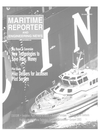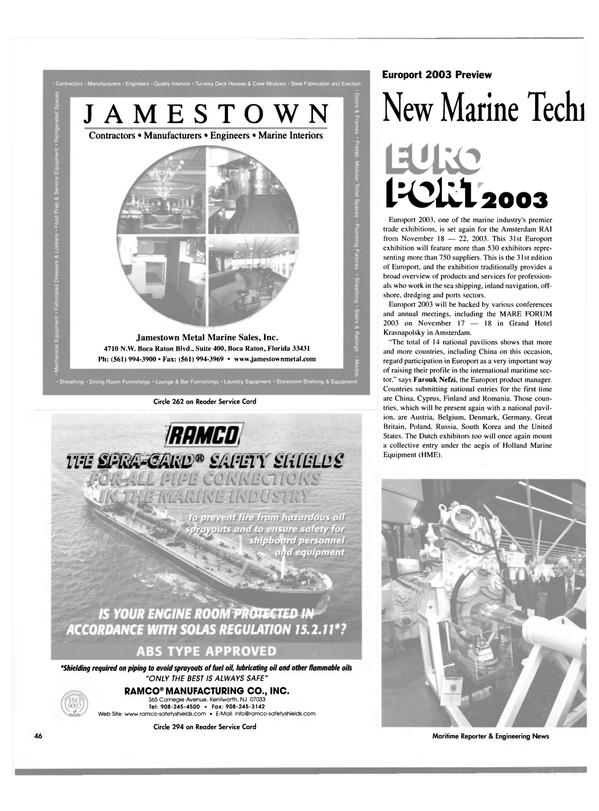
Gesilco: Built to last
In 1993 the first Geislinger Gesilco glass fiber coupling was put into operation on a fast ferry, built in Spain. The Gesilco was caught up with the same "fate " as any other new invention: its introduction was met with wide-spread skepticism at engine builders, classification societies and operators. However, success in operation has proven the product effective.
Gesilco is touted by the manufacturer as the lightest coupling on the market.
At the same time it is designed to be extremely loadable, has an outstanding misalignment capability and very low reaction forces. All those characteristics were proven within the last 10 years over and over again, partly under the hardest conditions.
The material used for Gesilco couplings is glass and carbon fiber — which is also used in the aero-space industry.
These couplings are used in a number of applications, especially for fast monohulls or c a t a m a r a n s , but also for coastguard- or police-vessels, for yachts or test bench a p p l i c a t i o n s .
The power range for which the Gesilco couplings are used at the moment lies between 100 kW and 9,000 kW.
The latest product is the Gesilco disc, a flat membrane coupling for single bearing generator applications, which opens the door to many other fields of application.
Every year several hundreds of Gesilco couplings are produced at Geislinger's production plant in Bad St. Leonhard/Austria and are mainly combined with the well-proven, torsionalelastic high damping Geislinger couplings.
For more information from Geislinger Circle 3 9 on Reader Service Card
Read Gesilco: Built to last in Pdf, Flash or Html5 edition of October 2003 Maritime Reporter
Other stories from October 2003 issue
Content
- Blount Delivers 130-ft. CAT page: 10
- 10,850-HP AHTS Joins Seabulk Offshore Fleet page: 11
- Sibu: Ferries for Asia page: 12
- Grimaldi-Naples Launches RoRo Grande Amburgo page: 14
- U.S. Territorial Sea and Other Lines in the Water page: 16
- Varian, PARC Receive Security System Funding page: 22
- Wartsila to Concentrate on Marine and Service page: 22
- LPG Tanker Repaired, Modernized and Converted page: 24
- Financier Calls for a New Approach on Standards page: 26
- Bollinger Completes Major Conversion of Ned Ferry page: 27
- SENESCO Becomes Senesco Marine page: 28
- SPS Overlay: Fix Steel Decks Faster page: 30
- Team UMC Helps Navy Ship With Innovative VSP Switch page: 33
- B+V Reports Busy Repair Docks in August page: 34
- Extensive Fantasy Refurb page: 35
- New Tooling, Training Solutions Target Shipbuilding page: 36
- Dubai Drydocks Completes Conversions page: 38
- Solutions in Panama page: 38
- Insurer Not Liable for Repairs Beyond Warranty page: 39
- The Evolution of Marine Painting page: 40
- Grand Bahama Shipyard Receives Quality Mark page: 41
- Brunei Develops New Coating System page: 42
- New Marine Technology Set for Debut at Amsterdam Exhibition EURO PORT 2003 page: 46
- Gesilco: Built to last page: 48
- Radio Holland page: 51
- Nauticast AG page: 51
- Autoship Continues To Make Waves page: 54
- Maxsurf Links with ShipConstructor page: 54
- Provide Solutions Introduces 3D Laser Scanning page: 56
- Nupas-Cadmatic Offers Versatile Shipbuilding Applications page: 57
- ABS President Discusses Bulk Carrier Safety page: 58
- Integrity in a New Era page: 60
- More Power to the Dredgermen page: 60
- CNG Carrier One Step Closer page: 61
- JJMA on LSC Team page: 63
- A Legacy Spanning Three Generations page: 64
- World Maritime Tech Exhibition Set for San Francisco page: 66
- Juniper's Hinges Go Low and High page: 68
- Long Beach Pilots Go Far Out With New Boat page: 72
- Urethane's Products Are Thick-Skinned page: 76
- SES Launches "Smart" Solution page: 77
- BP's Shafts are Oil-Free page: 80
- Vosta Debuts Universal MK3 Bow Coupling Installation page: 81
- Safety Not Optional page: 81
- VENTIQ Offers Innovative Approach to Cargo Tank Venting page: 82
- Walform M Plus: Leak Free pipe connections page: 82
- Employees' Invention Improves Valve Process page: 83
- New High-Pressure Pumps page: 83


